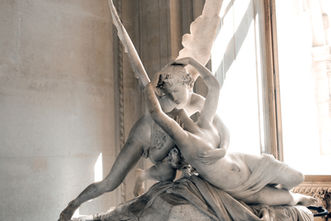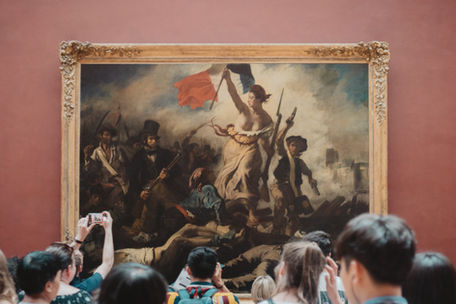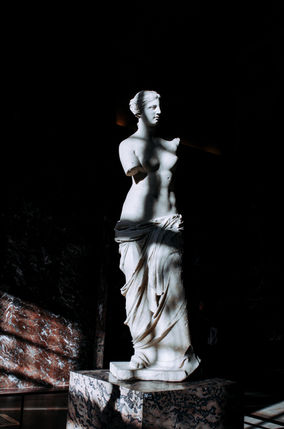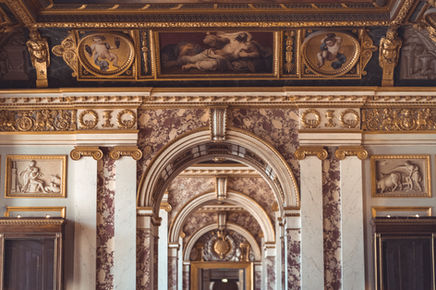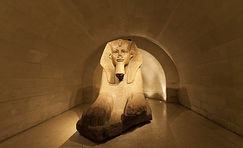
The Louvre museum
Here you are in front of the most legendary museum in all of Paris!
The Louvre Museum is one of the largest museums in the world, located in the 1st arrondissement of Paris.
It was built in the 12th century as a royal fortress and was converted into a museum in 1793.
Since then, it has become one of the most important symbols of French culture.
His history
Is it really necessary to point out that the Louvre Museum is a stunning place of art and culture, housing an exceptional collection of ancient and modern works of art in an architecturally astonishing building?
It is an absolutely unmissable historical and cultural site for art enthusiasts and visitors from all over the world, you will have no excuse!
The Louvre conceals treasures including an exceptional collection covering antiquity to the end of the 19th century. Art styles featured includethe Renaissance, Baroque, Classicism, as well as works of Oriental and Islamic art. Among the most famous works are Leonardo da Vinci's Mona Lisa, the Venus de Milo, the statue of the goddess Victory of Samothrace, and the gilded bronze sculpture of The Victory of Samothrace.
The architecture of the Louvre is a mixture of different architectural styles, ranging from Renaissance to neo-classical. The building is also known for its pyramid, designed by architect I. M. Pei, which was added in 1989 and quickly transformed into a recognizable symbol of the Louvre across the world.
Many famous people have been associated with the Louvre over the centuries. Louis XIV, Napoleon Bonaparte, and Queen Victoria of England are some of the most important. In addition, the Louvre is also associated with several interesting anecdotes, such as the night of August 10, 1793, when the French Revolution opened the doors of the Louvre for the first time to the public, or the story of the Mona Lisa, which was stolen in 1911 and remained undiscovered for two years.
“The Louvre is a miracle of humanity, a collection of treasures that transports us to the past.” - Orhan Pamuk, Turkish writer.
“The Louvre is the very symbol of the history of art in Europe, a true sanctuary for culture lovers.” - Paulo Coelho, Brazilian writer.
“The Louvre is one of the most wonderful places in the world, where the masterpieces of history are preserved and exhibited.” - Martin Scorsese, American director.
“The Louvre is humanity’s testament to creativity, an inexhaustible source of discovery for future generations.” - Isabel Allende, Chilean writer.
"The Louvre is a symbol of France's cultural richness, a place where the greatest works of art are brought together to inspire and amaze people." -Brad Pitt
Current exhibitions
The Louvre through time...
The Louvre, this magnificent palace locatedin the heart of Paris in the 1st arrondissement, is one of the greatest cultural and historical institutions in the world. For centuries, it has witnessed the evolution of France, welcoming in turn famous kings, queens, artists and scientists.
At the beginning of its history, the Louvre was a simple fortified castle, built to protect the city of Paris from enemy invasions. However, over time, this castle was transformed into a magnificent palace, welcoming royal families and their distinguished guests.
In the 17th century, King Louis XIV made the Louvre his principal residence, bringing his pomp and luxury there, and thus transforming the palace into a true architectural jewel. Under his reign, the Louvre became the scene of lavish parties and social receptions, where artists, scientists and philosophers gathered to exchange ideas and knowledge.
But it was not until the 18th century that the Louvre began to take its current form, when King Louis XV decided to expand and modernize the palace to make it the largest museum of art and antiquities in the world. Under his reign, prestigious collections were assembled, famous artists were commissioned to paint frescoes andpaintings, and talented architects were hired to remodel and beautify the palace.
Today, the Louvre has become a true cultural treasure, housing thousands of works of art from all eras and cultures, as well as historical and scientific remains. Every day, thousands of visitors from all over the world flock to its doors to discover the wonders found inside, including Leonardo da Vinci's famous Mona Lisa.
The biggest exhibitions at the Louvre Museum over the years:
-
Vermeer and the Masters of Genre Painting (2020)
-
Leonardo da Vinci (2019)
-
From Siena to Paris. The collection of Mathieu de la Roque (2015)
-
Picasso and Spanish modernity (2010)
-
Ancient Egypt (2007)
-
Tutankhamun (1967)
-
Napoleon I and the empire (2000)
-
Delacroix (2017)
-
Ramses, the Pharaoh of Egypt (2017)
A visit itinerary among others
The Louvre Museum is one of the most visited museums in Paris and it is also the first, followed by theOrsay Museum, ofGeorges Pompidou Center, ofTokyo Palace andQuai Branly Museum.
Although immense, here is a plan for visiting the Louvre if you only have 2 hours:
Wing of Flora: you will find the Mona Lisa (La Gioconda or Mona Lisa) there as well as othersItalian paintings and European.
Denon Wing: This wing contains Egyptian collections, Greek, Roman and Etruscan antiquities, as well as French and European paintings.
Richelieu Wing: It consists of European paintings, sculptures and objects of art, including works by Vermeer, Rembrandt, Rubens and Murillo.
Sully Wing: It contains the medieval and Renaissance collections, as well as French and European sculptures.
Start at the Louvre Pyramid to enter the museum.
Go to the Denon Wing and visit rooms 7 and 8 to see the Egyptian collections, Greek, Roman and Etruscan antiquities.
Visit the Salle des Estates to see the Mona Lisa (La Gioconda or Mona Lisa).
Go to the Richelieu Wing to see French and European paintings, such as the Venus de Milo in Greek and Roman sculptures and Veronese's The Marriage at Cana.
Visit the Galerie d'Apollon to see French paintings and European art objects.
Go to the Sully Wing to see the medieval and Renaissance collections, such as Michelangelo's Madonna and Child and Raphael's Madonna and Child Surrounded by Saints.
If you still have time, you can visit other rooms to see the collections of Asian art, Islamic art, etc.
It is difficult to make choices, as you will have understood, considering the masterpieces in this incredible museum. But if we had to list the most notable rooms:
The Louvre pyramid
The Apollo Gallery
The Hall of States
The Square Court
Egyptian collections
The room of European Paintings
Greek and Roman sculptures
The illumination room












Some works in light



The Mona Lisa (Mona Lisa) by Leonardo da Vinci - This oil painting on poplar wood panel was painted by the famous Italian Renaissance artist, Leonardo da Vinci, between 1503 and 1519. It is considered the one of the most famous and mysterious works in the world. The woman depicted is Lisa Gherardini, the wife of a Florentine merchant, and the painting is notable for its use of the sfumato technique, which creates subtle transitions between colors and shadows to give the figure a more natural appearance . The Mona Lisa was acquired by King Francis I in 1518 and became part of the French royal collection, before being transferred to the Louvre in 1797.
The Mona Lisa is also known for the many theories and interpretations that have been proposed about the meaning of the painting and figure. Some have suggested that the Mona Lisa's enigmatic smile is a symbol of the perfection of female beauty, while others have suggested that the painting is an allegorical representation of knowledge or wisdom. Additionally, the Mona Lisa has also been the subject of several acts of vandalism and theft throughout its history, which has contributed to its mystique and fame.
Mona Lisa (Mona Lisa) by Leonardo da Vinci - This oil painting on poplar wood panel measures 77 cm by 53 cm and is considered a masterpiece of the Italian Renaissance. She is famous for the mysterious smile of the woman depicted, as well as the subtle details and sfumato technique that Da Vinci used to paint her.







The Venus de Milo - This marble sculpture of the Greek goddess Aphrodite was created between 130 and 100 BCE, probably by Alexandros of Antioch. The sculpture was discovered on the island of Milos in 1820 and was acquired by the Louvre in 1821. The Venus de Milo is notable for its classical beauty and the way it depicts the human form, as well as for its elegant and graceful, which reflects the Hellenistic period.
The Venus de Milo is also important for its role in the depiction of female beauty in ancient Greek art. The sculpture depicts the goddess of love in a graceful and elegant pose, with ideal proportions that reflect the beauty standards of the time. Additionally, the sculpture has also been the subject of numerous interpretations and analyses, with some suggesting that it depicts the goddess rising from the sea, while others consider it a symbol of love and femininity.







The Coronation of Napoleon is a monumental painting by Jacques-Louis David, a French neoclassicist artist, created in 1805-1807 to celebrate the coronation of Napoleon Bonaparte as Emperor of the French. The painting measures almost 10 meters long and 6 meters high, making it one of the most imposing works in the Louvre.
The painting represents the coronation ceremony, which took place in December 1804 at Notre-Dame Cathedral in Paris. Napoleon is standing on a pedestal, wearing the imperial crown and holding the scepter and the globe, while the crown is placed on the head of his wife, Joséphine, kneeling before him. The figures in the painting are arranged symmetrically around the emperor, with dignitaries and members of the imperial family in key roles.
The Rite of Napoleon is considered one of the most important works of David and of neoclassical art in general. The painting is notable for its grandeur and attention to historical detail, reflecting David's interest in ancient history and dramatic setting. The composition of the painting is also carefully constructed, with perfect symmetry and balance between the figures, which reinforces the impression of grandeur and power.




The Victory of Samothrace is one of the most famous sculptures in ancient Greek art and is currently in the Louvre Museum. The sculpture depicts the Greek goddess Nike (Victory), who is depicted as a winged female figure, standing on a warship, emerging from the sea.
The sculpture is remarkable for its realism and dynamics, and for the quality of its representation of the human figure. The sculpture is also notable for its imposing size and its position on a pedestal at the top of a staircase, which gives the impression that the figure is flying.
The sculpture of The Victory of Samothrace was created around 190 BC. BC and is considered an exceptional example of art from the Hellenistic era. It was found in pieces on the island of Samothrace in 1863 by French archaeologist Charles Champoiseau and was restored before being exhibited at the Louvre.
Liberty Leading the People is a large-format painting created by the French painter Eugène Delacroix in 1830 to commemorate the July Revolution of the same year. It is considered one of the most important works of 19th-century French art and is now in the Louvre Museum.
Liberty Leading the People depicts an allegory of freedom, a woman waving a tricolor atop a barricade, surrounded by a rioting crowd, with the ruins of a royal palace in the background. The painting is known for its dramatic use of color, powerful composition and expressive style.
The use of bright colors and high contrasts in the painting gives the impression of frenetic movement and dynamic action, enhanced by the pose of the main figure of Liberty, who is waving his flag. The composition of the painting is also very thoughtful, with a diagonal running across the painting, spiral shapes and lines of force that draw the eye towards the center of the composition.
Liberty Leading the People is not only an important work of art, but it also has considerable historical significance. It represents a symbol of the struggle for liberty, equality and fraternity, values that inspired the French Revolution and the popular uprisings that followed. The painting is also a testament to Delacroix's commitment to social and political justice, as well as the Romantic ideals of passion and emotion.
The Hammurabi Code Stele is of great historical and legal importance because it provides valuable information about the life and laws of ancient Mesopotamia, as well as how the legal system functioned at that time. The Hammurabi Code was written around 1754 BC and includes 282 articles that cover topics such as marriage, divorce, inheritance, property, labor relations, financial obligations, criminal laws and civil liability.
The text is written in Akkadian, an ancient language of Mesopotamia, and the laws are presented in very precise and formal language, with specific legal expressions and technical terms.
The Hammurabi Code is also notable for the way it reflects Babylonian society of the time, where agriculture and animal husbandry were the main economic activities. Laws are designed to protect the interests of landowners, artisans, and merchants, and to maintain social order and stability.



Image Gallery







